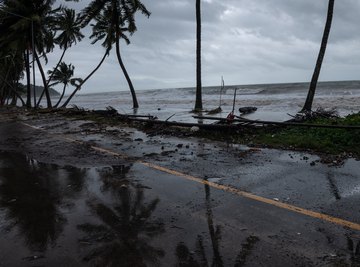
Tsunamis are the result of a rapid displacement of ocean water. The energy of the displacement pushes a large surge of water racing across the ocean at speeds of up to 500 miles per hour--as fast as a jetliner. While a tsunami may only appear on the open ocean as a rise of a foot or two, the wave can have a devastating and destructive impact as it reaches a shoreline.
Plates
The Earth is composed of a large scale network of tectonic plates that are constantly in motion. Often, the shift is merely an inch or two each year. Sometimes forces build up over time and a shift occurs more violently as stored energy is released along faults, or in deep ocean trenches where plates collide. All seas and landmasses have fault lines, but the Pacific Ocean is noted for a “Ring of Fire,” an active geological region where earthquakes, shifting crust and volcanoes are common.
Subduction Earthquakes
As plates smash into one another, earthquakes result. When these collisions cause one plate to slide beneath the other, a subduction earthquake occurs. The sudden and violent vertical shift of Earth’s crust often triggers a tsunami as tons of ocean water are thrust upward and the downward pull of gravity sends the water rapidly across the ocean. Not all earthquakes result in a tsunami and not all tsunamis traverse the entire span of ocean. The shock of some quakes is absorbed by the ocean and the surrounding geography of bays and landmasses dictates how a tsunami travels.
Other Causes
Subduction earthquakes are the most common cause of tsunamis, but they are not the only cause. Other shifts occurring in large sections of Earth’s crust can also trigger a tsunami. A landslide either underwater or along a coastline can move enough material to displace the large volumes of water necessary to create a tsunami. Calving glaciers, those that crack into one or more massive chunks, also push water into a tsunami. Underwater volcanoes that occur near the surface are strong enough to displace water and cause a tsunami. A rare event is an oceanic strike by a comet or meteor that sends columns of water in all directions from where the object fell.
Shoreline Effect
In a deep ocean, the displaced water may be barely noticeable, but the stored energy inside a fast-moving tsunami is released as the wave or surge reaches shallow water. The wave slows down, but the energy inside causes its height to grow. The wave tops move faster then the base, which causes tsunamis to rise quickly and to heights of 100 feet or more as they strike land. The trough, or low point of a wave, reaches the shoreline first. As it does, water along the coast is drawn seaward and the sea floor near shore is exposed momentarily, typically for about five minutes before the first crest hits. A tsunami is usually experienced as a series of waves, called a wave train, that amplifies the destructive nature of these natural disasters.
References
About the Author
Robert Korpella has been writing professionally since 2000. He is a certified Master Naturalist, regularly monitors stream water quality and is the editor of freshare.net, a site exploring the Ozarks outdoors. Korpella's work has appeared in a variety of publications. He holds a bachelor's degree from the University of Arkansas.
